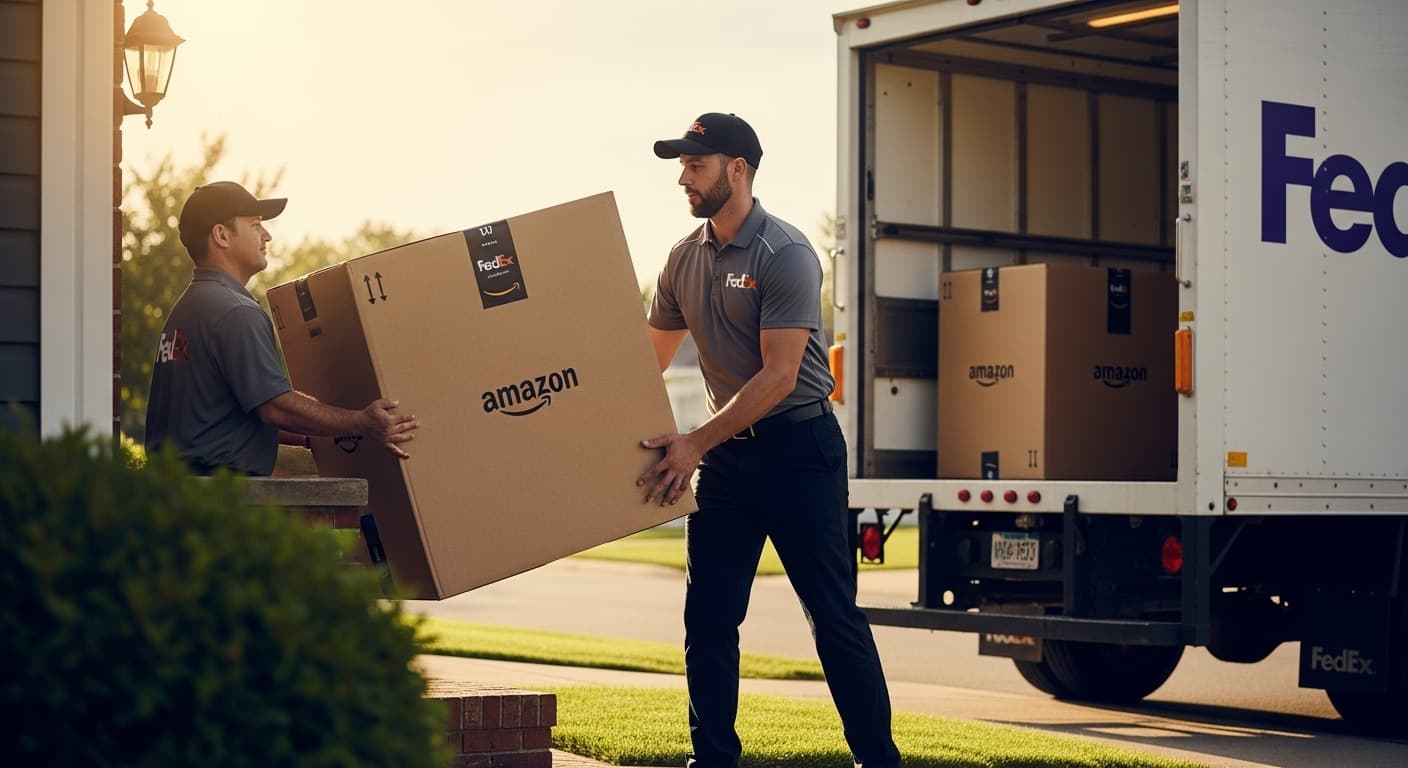
Executive Summary
The 2025 renewal of the Amazon-FedEx delivery partnership, focusing specifically on residential large package delivery, represents significant development in parcel delivery market dynamics. This partnership follows a seven-year period during which Amazon developed substantial internal logistics capabilities, now handling approximately 6 billion packages annually and achieving roughly 28% U.S. market share by volume. The focused partnership targeting “big and bulky” residential deliveries reflects strategic positioning by both organizations—Amazon seeking specialized handling capabilities for oversized items, and FedEx pursuing higher-margin business segments. Concurrent UPS workforce adjustments and strategic repositioning toward commercial segments further illustrate evolving competitive dynamics. This analysis examines partnership implications, market structure changes, and strategic considerations for organizations relying on parcel delivery services in this transformed competitive landscape.
Amazon-FedEx Partnership Renewal: Parcel Delivery Market Analysis
(亚马逊-联邦快递合作关系:包裹递送市场分析)
The parcel delivery industry undergoes continuous evolution driven by e-commerce growth, technological advancement, and changing competitive dynamics. Understanding these developments supports informed logistics strategy.
Partnership Evolution and Market Context
Historical Relationship Background
Initial Partnership Period:
Amazon and FedEx maintained delivery relationships during Amazon’s growth phase:
Original Cooperation:
- Service Provider Role: FedEx handling significant Amazon delivery volumes
- Ground Network: Utilizing FedEx Ground for residential deliveries
- Standard Relationship: Traditional carrier-customer dynamic
- Volume Growth: Increasing Amazon shipment volumes over time
2019 Separation:
The relationship paused as both companies pursued different strategies:
FedEx Strategic Considerations:
- Margin Pressure: High-volume, lower-margin business affecting profitability
- Competitive Concerns: Amazon’s growing logistics capabilities
- Strategic Focus: Emphasis on more profitable business segments
- Resource Allocation: Capacity dedicated to premium customers
Amazon Response:
- Internal Development: Accelerated logistics infrastructure investment
- Capability Building: Development of comprehensive delivery network
- Scale Achievement: Rapid growth in internal delivery capacity
- Market Position: Evolution from customer to competitor
Amazon Logistics Development
Infrastructure Growth:
During the separation period, Amazon built substantial logistics operations:
Physical Infrastructure:
- Fulfillment Centers: Over 200 facilities nationwide
- Total Facilities: 2,000+ locations including various facility types
- Delivery Fleet: Approximately 120,000 trucks and vans
- Geographic Coverage: Service to 95% of U.S. population within two days
Operational Scale:
- Package Volume: 6-6.3 billion packages delivered in 2024
- Market Share: Approximately 28% by volume according to industry analysis
- Seller Services: Supporting 600,000+ independent sellers
- Third-Party Services: Expanding services beyond Amazon’s own e-commerce
Technology Integration:
- AI Optimization: Machine learning for routing and logistics
- Predictive Analytics: Demand forecasting and inventory positioning
- Real-Time Tracking: Comprehensive visibility across network
- Customer Interface: Integrated ordering and delivery experience
Partnership Structure and Strategic Focus
Large Package Specialization
Service Scope:
The renewed partnership targets specific delivery categories:
“Big and Bulky” Definition:
- Furniture: Couches, mattresses, dining sets, bedroom furniture
- Exercise Equipment: Treadmills, weight machines, home gym systems
- Large Appliances: Washers, dryers, refrigerators, dishwashers
- Electronics: Large televisions, home theater systems
- Home Improvement: Tools, building materials, outdoor equipment
Operational Characteristics:
- Specialized Handling: Requirements beyond standard parcel processing
- Equipment Needs: Specific vehicles and handling equipment
- Delivery Complexity: White glove, threshold, or room-of-choice services
- Margin Profile: Higher per-shipment margins than standard parcels
Strategic Rationale
Amazon Perspective:
The partnership addresses specific operational needs:
Capability Access:
- Specialized Services: Handling expertise for oversized items
- Network Complement: Augmenting internal capabilities in specialized segment
- Cost Optimization: Potentially favorable economics for certain shipments
- Customer Experience: Enhanced service quality for large item deliveries
Resource Focus:
- Internal Capacity: Concentrating owned assets on core parcel volumes
- Capital Efficiency: Utilizing partner capabilities rather than building all internally
- Network Optimization: Strategic use of different networks for different needs
- Growth Support: Capacity for expanding large item sales
FedEx Perspective:
The partnership supports strategic objectives:
Business Focus:
- Margin Optimization: Higher-margin services alignment
- Capability Utilization: Leveraging existing specialized infrastructure
- Volume Access: Significant volumes in growing segment
- Competitive Positioning: Differentiation through specialized services
Strategic Alignment:
- Service Differentiation: Focus on complex, high-value services
- Network Utilization: Effective deployment of ground network assets
- Growth Segments: Participation in expanding large item e-commerce
- Reduced Competition: Limited overlap with Amazon’s standard delivery operations
Competitive Market Dynamics
Market Share Evolution
Volume-Based Share (2024-2025 Estimates):
| Carrier | Estimated Market Share | Key Characteristics |
|---|---|---|
| USPS | ~31% | Last-mile partnerships, cost leadership |
| Amazon Logistics | ~28% | Rapid growth, vertically integrated |
| UPS | ~21% | Premium services, commercial focus |
| FedEx | ~15% | Express services, specialized segments |
| Regional/Other | ~5% | Niche services, regional focus |
Revenue-Based Share:
Market share by revenue shows different dynamics:
Revenue Distribution:
- UPS: Approximately 34% revenue share reflecting premium pricing
- FedEx: Approximately 31% revenue share with express and international strength
- Amazon: Approximately 17% revenue share with lower margins but high volume
- USPS: Lower revenue share despite volume leadership
- Others: Growing segment of specialized providers
UPS Strategic Repositioning
Workforce Adjustments:
UPS announced significant organizational changes:
Scale of Changes:
- Job Reductions: Approximately 20,000 positions affected
- Facility Consolidation: Closure of 73 facilities
- Network Optimization: Restructuring for operational efficiency
- Strategic Refocus: Emphasis on profitable segments
Amazon Volume Changes:
- Reduction Trajectory: Decreasing Amazon-related volumes
- Business Mix: Shifting away from certain Amazon fulfillment center outbound parcels
- Profitability Focus: Eliminating lower-margin business
- Capacity Reallocation: Resources directed to premium services
Strategic Direction:
UPS articulates clear strategic priorities:
Market Focus:
- B2B Emphasis: Commercial and business-to-business services
- Healthcare Logistics: Specialized temperature-controlled and regulated shipments
- International Services: Global network leverage
- Premium Segments: Higher-value, time-sensitive deliveries
Operational Priorities:
- Margin Improvement: Enhancing profitability per shipment
- Service Quality: Premium service levels for retained customers
- Technology Investment: Automation and efficiency systems
- Network Efficiency: Optimized facility and route networks
Implications for Shippers and Logistics Professionals
Strategic Considerations
Delivery Network Evaluation:
Organizations can assess delivery strategies considering market changes:
Carrier Selection Factors:
- Service Requirements: Matching carriers to specific needs
- Cost Structures: Understanding pricing across different services
- Geographic Coverage: Network reach for relevant destinations
- Specialized Capabilities: Services for unique requirements
Large Package Considerations:
Organizations shipping oversized items face specific considerations:
Service Options:
- Specialized Networks: Carriers with large item expertise
- Handling Capabilities: White glove and installation services
- Cost Comparison: Evaluating alternatives for oversized shipments
- Customer Experience: Service quality for sensitive deliveries
Risk Management:
Evolving competitive dynamics warrant risk assessment:
Carrier Diversification:
- Multiple Relationships: Avoiding single-carrier dependency
- Backup Options: Alternative carriers for continuity
- Geographic Diversity: Different carriers for different regions
- Service Mix: Balancing cost and service requirements
Technology and Integration
Visibility Requirements:
Modern delivery management requires comprehensive visibility:
System Capabilities:
- Multi-Carrier Tracking: Consolidated visibility across carriers
- Performance Analytics: Metrics on cost, timing, and quality
- Exception Management: Identifying and addressing delivery issues
- Customer Communication: Real-time updates and notifications
Integration Considerations:
- API Connections: Technical integration with carrier systems
- Data Standards: Consistent data across different carriers
- Process Automation: Reducing manual handling and errors
- Reporting Capabilities: Analytics supporting decision-making
Broader Industry Trends
Market Structure Evolution
Beyond Traditional Big Three:
The market structure continues diversifying:
Emerging Participants:
- Regional Carriers: Specialized geographic or service focus
- Last-Mile Specialists: Urban and suburban delivery focus
- Technology Platforms: Digital-first delivery services
- Vertical Specialists: Industry-specific logistics providers
Amazon’s Expanding Role:
Amazon increasingly serves external customers:
Third-Party Services:
- Supply Chain by Amazon: Services for independent sellers
- Multi-Platform Support: Fulfillment for other marketplaces
- Logistics Services: Competition with traditional 3PLs
- Technology Offerings: Platform capabilities for logistics management
Service Specialization
Segment Differentiation:
The industry shows increasing specialization:
Service Categories:
- Standard Parcels: Commoditized, price-competitive segment
- Large Packages: Specialized handling, premium pricing
- Express Services: Time-definite, premium margins
- B2B Logistics: Commercial relationships, consistent volumes
Market Positioning:
- Cost Leadership: Competing primarily on price
- Service Differentiation: Unique capabilities and quality
- Specialized Focus: Expertise in specific segments
- Technology Leadership: Advanced systems and customer experience
Economic and Market Considerations
Market Size and Growth
Industry Scale:
The parcel delivery market represents substantial economic activity:
Market Metrics:
- Global Market Size: Projections exceeding $500 billion
- U.S. Daily Volume: Approximately 67 million parcels
- Growth Projections: Continued expansion driven by e-commerce
- Employment: Hundreds of thousands of jobs across sector
Growth Drivers:
- E-Commerce Expansion: Online retail continuing to grow
- Consumer Expectations: Demand for fast, convenient delivery
- Market Penetration: Geographic and demographic expansion
- Service Innovation: New capabilities and offerings
Cost Structure Implications
Pricing Dynamics:
Market changes affect pricing across segments:
Factors Influencing Costs:
- Capacity Utilization: Network efficiency and volume
- Service Level: Speed and handling requirements
- Geographic Factors: Distance and delivery density
- Competitive Pressure: Market dynamics affecting rates
Shipper Considerations:
- Rate Negotiations: Leveraging competitive dynamics
- Service Mix: Balancing cost and requirements
- Volume Commitments: Relationship with pricing
- Long-Term Trends: Planning for evolving costs
Strategic Frameworks for Organizations
Delivery Strategy Assessment
Evaluation Dimensions:
Organizations can assess delivery approaches systematically:
Strategic Questions:
- Service Requirements: What delivery capabilities do we need?
- Cost Objectives: What represents acceptable delivery cost structure?
- Growth Plans: How will delivery needs evolve?
- Competitive Position: How does delivery affect our market position?
Analysis Framework:
- Current State: Understanding existing delivery operations and costs
- Gap Analysis: Identifying areas for improvement or change
- Alternative Evaluation: Considering different approaches and carriers
- Implementation Planning: Developing transition strategies
Partnership Approach
Carrier Relationships:
Building effective carrier partnerships:
Relationship Elements:
- Mutual Understanding: Clear expectations and requirements
- Performance Metrics: Agreed measures of success
- Communication: Regular dialogue on performance and changes
- Continuous Improvement: Collaborative problem-solving
Strategic Considerations:
- Portfolio Management: Optimizing mix of carrier relationships
- Risk Distribution: Appropriate diversification
- Service Matching: Aligning carriers with specific needs
- Cost Management: Balancing rates across portfolio
Conclusion: Understanding Evolving Delivery Markets
The renewed Amazon-FedEx partnership, focused on large package residential delivery, illustrates continuing evolution in parcel delivery markets. The partnership reflects strategic positioning by both organizations within a competitive landscape characterized by specialization, technological advancement, and changing customer expectations.
Key Insights
Market Evolution:
Several trends characterize the current environment:
- Specialization: Increasing focus on specific service categories and segments
- Technology Integration: Digital capabilities becoming essential
- Service Differentiation: Quality and capabilities competing alongside cost
- Competitive Complexity: More diverse participant types and business models
Strategic Implications:
Organizations managing delivery operations can consider:
- Carrier Assessment: Regular evaluation of carrier options and performance
- Service Matching: Aligning carriers with specific requirements
- Risk Management: Appropriate diversification and contingency planning
- Technology Investment: Systems supporting efficient multi-carrier management
Ongoing Adaptation:
The parcel delivery sector continues evolving:
- Market Structure: Participants adjusting strategies responding to competition
- Service Innovation: New capabilities and offerings developing
- Technology Advancement: Digital systems enhancing efficiency
- Customer Expectations: Continuing evolution of delivery requirements
Practical Application
Understanding these market dynamics supports effective logistics strategy:
- Informed Decisions: Carrier selection based on comprehensive analysis
- Cost Optimization: Leveraging competitive dynamics and service matching
- Service Quality: Maintaining delivery performance aligned with customer needs
- Flexibility: Maintaining adaptability to continuing market evolution
The parcel delivery industry’s transformation reflects broader trends in logistics, technology, and consumer behavior. Organizations that understand these dynamics and develop thoughtful strategies will be better positioned to manage delivery operations effectively within this evolving environment.
Advanced Logistics Solutions provides parcel delivery strategy consulting, helping organizations evaluate carrier options, optimize delivery networks, and develop effective approaches to managing shipping operations. Our specialists offer expertise in carrier selection, contract negotiation, and delivery network design. Contact our team to discuss delivery strategy considerations for your organization.



